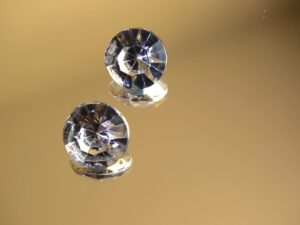
Online shopping is a pastime ever-increasing in popularity, but unfortunately, this comes to an abundance of scams that breed mistrust among individuals hoping to buy opal jewellery online. So, we have compiled this list of considerations that all online shoppers should look for to give you a sense of security when purchasing opal jewellery online.
The Risks of Buying Australian Black Opals Online
There is so much to learn when buying an Australian black opal online. Opals are complex and sophisticated gemstones with great potential for genuine investment value or the disappointment of buying a fake or ‘treated’ gemstone.
It is a little known fact that Australian Black Opals are arguably the world’s rarest ‘commercially available gemstone’, and while choosing your black Opal can be complicated and fraught with traps and tricks, the following tips will help you find the right Opal at the right price and stay away from the fakes.
Black Opals are extremely rare. If you see a Black Opal online with bright colours and lots of ‘fire’ for less than $1000, then beware! Take a closer look as there is a very high likelihood that this is a fake, a treated Opal or a synthetic lab-grown replicant.
‘Fakes’ look exactly like an authentic Australian Black Opal and are often advertised as ‘Australian Opal’. Sometimes in the fine print, it will say ‘synthetic’ or ‘replicant’ or ‘type 3’, but there are many cases online where the truth is hidden!
What to Look for in an Online Opal Jewellery Seller
In person, it’s straightforward to examine an opal since you can hold it, feel the metal, and move the stone to see all its natural flashes of colour. That is not always achievable when buying opal jewellery online.
When purchasing from a website, you should ensure that you can see multiple images of the same stone shot from various angles. This is not essential to avoid a scam,’ but rather to provide further information on the stone itself so that you are better informed on what you are purchasing. Unfortunately, the internet tendency is to brand base metal and portray plastic or processed Opal as “Australian” or “natural” Opal, which might lead you to believe something is worth more than it is.
One of the most important signs of a reputable online opal jewellery seller is store reviews! Both positive and negative reviews can reveal two things:
A genuine customer base has received their item and can give insight into its condition.
The presence of unfavourable reviews might reveal where the seller went wrong and whether the issues were remedied.
Do not hesitate to contact a corporation, store, or local jeweller with inquiries regarding your prospective purchase. A reliable online opal jewellery retailer will be open to queries and may even supply more photographs of your product in a different setting, which, while little, may have a significant impact on your overall view of the gemstone or jewellery!
What is a Synthetic Opal?
Synthetic opals are artificial stones with the same internal composition, structure, and qualities as genuine opals. However, with the fabrication of these ‘lab-cheated’ gemstones comes an increase in the need for inexpensive and rapid jewellery; artificial synthetic Opal can meet this demand.
Synthetic opals have not only resulted in incorrect pricing and quality that has become usual for cheaper alternatives, but they have also contributed to the continuation of distrust between jewellers and those looking to buy opal jewellery online.
Gilson opal was initially developed in Switzerland but is currently mostly synthesised in Japan. This variety of Opal has been in existence since 1974. It is made of Silica, a genuine synthetic imitation of natural Opal. The phrase ‘Gilson opal’ is frequently used to describe imitation opals, which are gems that are not just manufactured but also contain minerals and elements that are not present in natural opals.
How to Identify Fake Opal Jewellery Online
It might be difficult to tell if an opal is genuine or not if you do not have prior knowledge of opal kinds. Many retailers worldwide offer Opal at steep discounts, with many customers not questioning the gem’s authenticity and instead of believing it to be ‘genuine.’
However, as the availability of synthetic opals (and their ability to simulate the appearance of authentic Opal) has expanded, so has their prominence in the internet jewellery industry. Many internet merchants utilise deceptive marketing strategies and can be offered under various names that do not expressly state that they are false inventions.
Currently, there aren’t many popular methods for determining whether an opal is natural. As described by gemologists, look for a ‘columnar’ structure or a snakeskin pattern. Turn the Opal over and search for crisp, linear lines of colour that go vertically! This is a tell-tale indicator of a fake Opal.
Under high magnification (about sixty), the regularity and columnar form of the Opal is readily seen, indicating that it is synthetic. In addition to visual indicators, synthetic opals will produce a green colour under UV light; it is generally recommended to bring a UV torch along to test if the stone ‘fluoresces,’ and if not, it is natural.
What is Ethiopian Opal?
The Ethiopian Opal emerges from the earth, appearing like a brown beer bottle and takes extensive treatment to reveal its colour. The chemical therapy is successful, although it is not long-lasting. Numerous clients have contacted us after experiencing the reverse shock of this procedure.
According to the World Bank, this is a problem that stems from a failure in Ethiopian government policy. This is frequently not communicated to the customer….and this is the issue. This can be difficult to negotiate because the Opal is technically ‘genuine.’ There are only negative side effects of long-term use that may or may not be revealed upfront.
Ready to Buy Opal Jewellery Online?
Overall, it is critical that you be alert and informed of what to look for when buying Opal jewellery online so that you can avoid the many methods designed to ‘dupe’ you and be satisfied and safe with your purchase.





